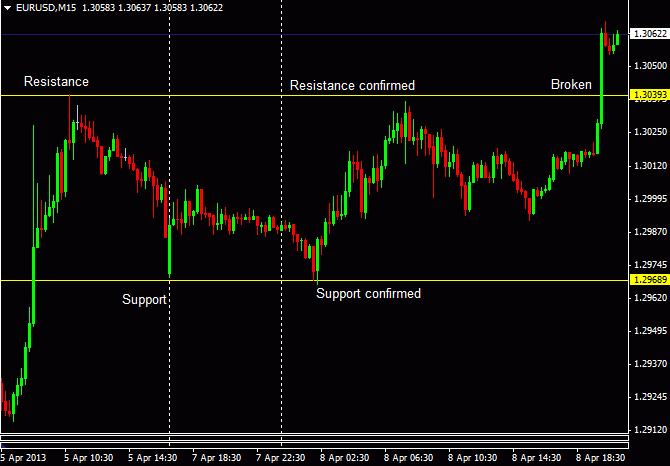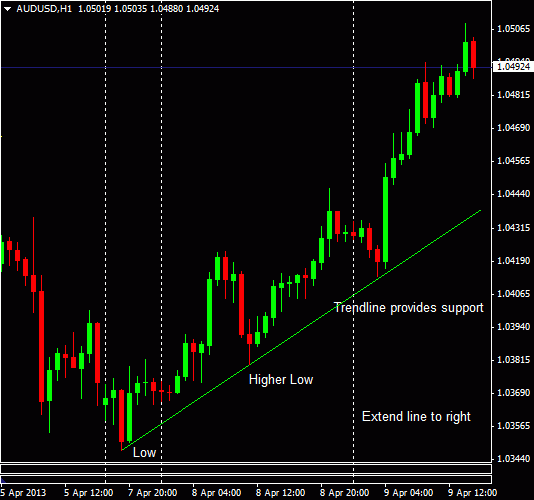Understanding Support and Resistance
When you begin trading using Technical Analysis (TA) and reading TA news and outlooks, inevitably you will hear about support and resistance (S&R). S&R are basics concepts of technical analysis, but are crucial elements within many traders strategies. Unfortunately, S&R is not often fully understood even by experienced traders. Below we look at what support and resistance are , and the major forms they can take, such as Horizontal, Diagonal, Historic and Predictive.
Support
Support, or Support Level, is a price at which buyers tend to enter an asset (stock, currency, future, commodity, etc). If a stock, for example, is falling and buyers enter the stock repeatedly near a similar price, pushing it higher, this would be a support level. In essence, support is like a floor, supporting the price. If the price drops below a support level, then support is broken. If the level isn’t broken, then support has been (re)confirmed or “support held.”
Resistance
Resistance, or Resistance Level, is a price at which sellers tend to enter an asset. If the S&P 500 futures, for example, are rising and sellers enter the futures repeatedly near a similar price, pushing it lower, this would be a resistance level. Resistance is like a ceiling, resisting a rise in price. If the price rises above a resistance level, then resistance is broken. If the level isn’t broken, then resistance has been (re)confirmed or “resistance held.”
Horizontal S&R
Most commonly discussed is horizontal support and resistance. A horizontal is a specific price, or a price area, which has supported or resisted price movement beyond it. Figure 1 shows an example of horizontal support and resistance.
Figure 1. EUR/USD 15 Minute Chart

Source: Oanda – MetaTrader
The price moves higher and stops near 1.3039; sellers enter and this now becomes a resistance level. This is confirmed a couple days later. Support kicks in near the 1.2970 region on a couple occasions as well. Eventually the price rallies and breaks through the resistance area.
As a very basic guideline, when the price moves through resistance it is a positive sign as it shows the price is making headway higher. When the prices moves through support it is a negative as it shows the price is progressing lower. For more on breakouts see Improving the Odds When Trading Intra-Day Breakouts.
If an asset breaks though support or resistance, but then shortly after crosses back through it in the opposite direction, this is a warning sign the breakout was false, and is called a false breakout.
Diagonal S&R
A horizontal support or resistance level/area is static, but with a diagonal the level is dynamic and will change over time. The most common form of diagonal support or resistance is created by a trendline. A line is drawn between a price low and a higher price low, or a price high and a lower price high, and then the line is extended out to the right to create a trendline. In this case it is not a specific price that brings in buyers or sellers, but rather the dynamics of the trend.
Figure 2. AUD/USD Hourly Chart

Source: Oanda – MetaTrader
If the diagonal is upward, the trend on that time frame is up. When the diagonal is down, the trend is down. It is important note though that there may different trends occurring on different time frames. As a general guideline, when the asset price bounces up off the trendline this is positive. It breaks below the trendline it is a warning signal of potentially further weakness. In a downtrend it is negative if the price can’t rally through the trendline, but if it does then it is warning the trend may turn up. For more on this topic, see Beginners Trading Concepts: Using Trendlines Effectively.
If an asset breaks though support or resistance, but then shortly after crosses back through it in the opposite direction, this is a warning sign the breakout was false, and is called a false breakout.
Historic
When traders refer to support or resistance, typically they are referring to historic price action to determine the level. This is especially true with horizontal S&R. We are looking to the past to see where price has struggled to rise above, or fall below, a certain threshold. These levels can help to determine entry or exit points or can used to create strategies. Diagonal S&R levels has a historic element, since we need at least two price lows or highs to create a trendline. The trendline though also has a predictive property, since it can be extended out to the right and therefore provides a rough estimate of where the trend may go in the future.
Predictive
Less common, but arguably more valuable, is predictive S&R. Trendlines are one from of predictive S&R, since the line extends out to the right and may support or resistance price movement in the future. Horizontal S&R may also be predictive as the price may continue to struggle to get through these levels in the future.
Traders also use other tools to determine where future support or resistance may develop. Such tools include Elliott Wave analysis, which uses wave patterns to determine where a price is within its overall trend. This information can then be used determine when the trend may reverse or continue on its course. Fibonacci retracements are another common tool. You may hear someone say “Expect support at the 50% retracement level.” While there may no horizontal or diagonal support at this level, many traders believe that markets correct and advance in Fibonacci numbers, and therefore use these numbers to predict where the market is likely to tucker out because it hits support or resistance.
These tools are beyond the scope of this article, but if you are interested, researching and understanding these tools and trading concepts can add another element to your trading.
Final World
Most traders think of support and resistance in terms of a set price, such as described in the Horizontal S&R section. There are other forms of S&R though, which include diagonal–such as trendlines–as well as predictive S&R which require the use of more complex tools. Use support and resistance to determine strength or weakness; if an asset is dropping through support levels, it is weak. If it is rising through resistance levels it is strong. If an asset breaks though support or resistance, but then shortly after crosses back through it in the opposite direction, this is a warning sign the breakout was false, and is called a false breakout. Before trading always have a game plan: Creating a Trading Plan